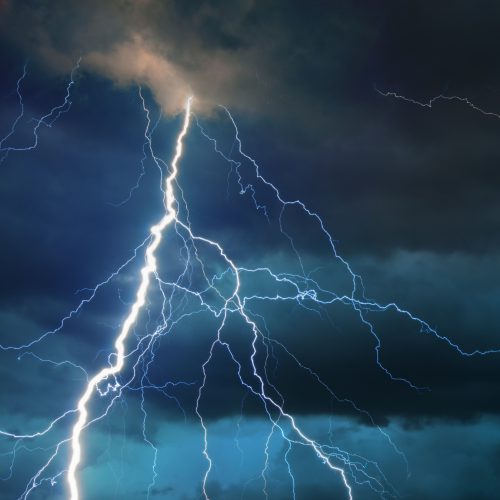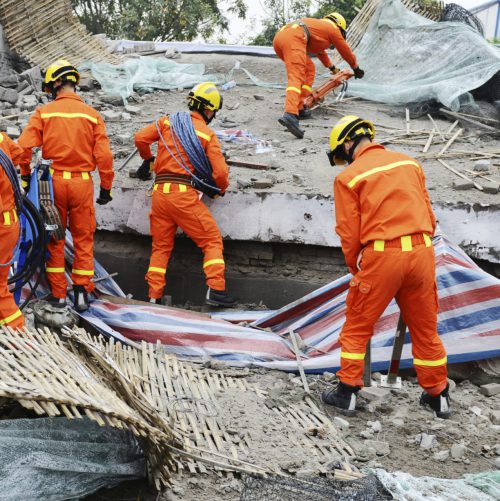
Nearly 3,000 people have been killed in the United States in the last five years because of weather-related events and conditions. Extreme weather events, including tornadoes, hurricanes, floods, and extreme temperatures can all be deadly.
The number of Americans killed by weather events and conditions varies widely from state to state. Geography, climate, and even economic status play a role in a particular state’s weather-related death rate. In order to determine the states with the most dangerous weather, 24/7 Wall St. reviewed state by state fatalities attributable to weather from 2011 through 2015 from the National Weather Service. Each of the states with the most dangerous weather had a five-year fatality rate that was more than double the national rate during that period.
Extreme heat is the most common cause of weather-related fatalities in the United States. Since 1988, there have been 3,806 heat-related fatalities compared to 830 deaths attributable to extreme cold. Recent trends suggest that the problem is likely to get worse. Four of the last five years rank as the hottest on record.
Click here to see the 7 states with the most dangerous weather.
Many of the states with the most dangerous weather, including Alabama, the state with the highest weather fatality rate, have high fatality figures due to a devastating series of tornadoes that tore across the Southeastern U.S. in late April 2011. Hundreds of lives were lost to more than 200 tornadoes, which wreaked havoc over a four-day period. Oklahoma, the state with sixth highest weather-related fatality rate, lies nearly in the center of Tornado Alley, an area notorious for the regularity with which tornadoes touch down.
In addition to extreme temperatures and powerful storms, flooding is one of the deadliest weather conditions in the United States. Heavy spring time rains, when combined with melting snowpacks, can lead to catastrophic flooding, particularly in areas along the Mississippi River. In fact, three of the seven states with the most dangerous weather are situated along the banks of the Mississippi. An average of more than 80 deaths are attributable to flooding every year in the United States.
While geography and climate play a central role in dangerous weather, poverty amplifies its negative effects. According to a report from the Centers for Disease Control and Prevention, weather-related death rates are “2 to 7 times as high in low-income counties as in high-income counties.” This is likely because those living below the poverty line to not have the means to prepare for, or adapt to, extreme weather events and conditions, according to the CDC. It is perhaps no coincidence that the poverty rate is as high or higher than the 15.6% national rate in each of the states on this list except for Wyoming.
To determine the states with the most dangerous weather, 24/7 Wall St. compiled state by state fatality rates attributable to weather from the National Weather Service, a component of the National Oceanic and Atmospheric Administration. We totalled all weather-related deaths from 2011 through 2015 and adjusted the five-year total for every 1 million state residents. The five-year period was used because weather fatalities are susceptible to large year-over-year fluctuations. The total value of damage caused by weather events also came from the NWS. Population and poverty figures came from the U.S. Census Bureau’s 5 year American Community Survey.
These are the states with the most dangerous weather.
7. Mississippi
> 5-year fatality rate: 26.4 (per million residents)
>Total fatalities 2011-2015: 79
>Total damage 2011-2015: $2.6 billion
>Poverty rate: 22.6%
Every five years, there are an average of 26.4 deaths due to weather events for every million people in Mississippi, the seventh highest such rate in the country and more than double the corresponding national rate of 9.4 fatalities per 1 million residents. Of the last five years, 2011 was the deadliest in Mississippi. Several natural disasters of historic proportions hit the state that year — disasters that contributed to a total of 40 weather related fatalities.
Over a four-day period in late April, 2011, hundreds of tornadoes touched down in the Southeastern United States, killing scores of people in several states, including Mississippi. In addition to the tornadoes, the Mississippi River flooded to levels not seen since the 1930s. The 2011 flood, while not as deadly as the tornadoes, cost an estimated $3.2 billion, more than any other flood in the Mississippi River Valley in at least the last three and a half decades.
6. Oklahoma
> 5-year fatality rate: 27.8 (per million residents)
>Total fatalities 2011-2015: 107
>Total damage 2011-2015: $3.3 billion
>Poverty rate: 16.9%
The five-year weather related death rate in Oklahoma is nearly three times the corresponding national rate. Weather events have claimed 107 lives and cost more than $3.3 billion in property and crop damage in the state during that time. For Oklahoma, 2013 was by far the worst year for weather in the last five. An EF5 tornado, the most powerful classification, touched down in Oklahoma that year, causing devastation along a 20 mile stretch of the state and claiming 24 lives. In 2011, the state was in the midst of a record-breaking heatwave, which devastated crops and led to multiple deaths. The state has also battled a severe and costly drought for much of the last five years.
5. Arkansas
> 5-year fatality rate: 30.8 (per million residents)
>Total fatalities 2011-2015: 91
>Total damage 2011-2015: $1.2 billion
>Poverty rate: 19.2%
Weather-related death rates are at least two times higher in poorer areas, according to the CDC. In Arkansas, which has the fifth highest weather-related death rate of all states, the poverty rate is also far higher than the national average. The state’s 19.2% poverty rate is fourth highest in the country.
The Mississippi River forms Arkansas’ eastern border, and when the river flooded to historic levels in 2011, the state was hit hard. Agriculture is the state’s biggest industry, and the 2011 flooding cost millions in crop damage. Flooding killed 18 people in Arkansas in 2011 alone.
4. Wyoming
> 5-year fatality rate: 34.5 (per million residents)
>Total fatalities 2011-2015: 20
>Total damage 2011-2015: $45.5 million
>Poverty rate: 11.6%
Unlike many of the other states on this list, destructive natural disasters are relatively uncommon in Wyoming. However, because it has the smallest population of any state, even a single weather-related fatality can have a dramatic effect on the overall rate. Over the last five years, 20 people have died because of weather in Wyoming, fewer than in the majority of other states. However, when adjusted for the population, the state’s weather-related deaths per capita is one of the highest in the country. Nearly three-quarters of all weather-related deaths in the state in the last five years were due to avalanches in the Teton, Snake River, and Wyoming Range.
3. Nevada
> 5-year fatality rate: 36.1 (per million residents)
>Total fatalities 2011-2015: 101
>Total damage 2011-2015: $133.0 million
>Poverty rate: 15.6%
Nevada is one of only a handful of states with more than 100 weather-related deaths in the last five years. It also has the third highest weather-related fatality rate in the country. The driest state in the country, much of Nevada is a desert. In 2013, 42 people were killed and another 576 were injured due to extreme weather in Nevada. That same summer, the state was in the middle of a heat wave that had swept across the Southwest, and multiple cities in the state reported near record high temperatures. Partially due to the heat wave, 2013 the deadliest year in the last half decade in Nevada.
2. Missouri
> 5-year fatality rate: 43.5 (per million residents)
>Total fatalities 2011-2015: 263
>Total damage 2011-2015: $3.5 billion
>Poverty rate: 15.6%
More than two-thirds of the total weather-related fatalities in Missouri in the last five years happened in 2011. That year, the city of Joplin was devastated by an EF5 tornado, the most powerful classification. The twister killed more than 160 people and injured over a thousand. 2011 was also the most costly year due to weather-related disasters in Missouri in the last half decade. Due largely to the tornado that all but destroyed Joplin, the estimated damage in Missouri that year was nearly $3.3 billion. The Joplin tornado ranks as one of the deadliest in U.S. history.
1. Alabama
> 5-year fatality rate: 61.1 (per million residents)
>Total fatalities 2011-2015: 295
>Total damage 2011-2015: $4.4 billion
>Poverty rate: 18.9%
Roughly 85% of all weather-related fatalities in Alabama in the last half decade occurred in 2011. That year, the state was the hardest hit by the weather event dubbed “The Tornado Super Outbreak of 2011.” In a four-day period in late April that year, tornadoes killed more than 230 people and injured thousands in Alabama.
Partially because they have fewer resources to prepare for disastrous weather conditions, people living in poverty are more likely to be killed by extreme weather. In Alabama, a state with the fifth highest poverty rate in the country, more people have died due to weather in the last five years than in any other state.
Credit Card Companies Are Doing Something Nuts
Credit card companies are at war. The biggest issuers are handing out free rewards and benefits to win the best customers.
It’s possible to find cards paying unlimited 1.5%, 2%, and even more today. That’s free money for qualified borrowers, and the type of thing that would be crazy to pass up. Those rewards can add up to thousands of dollars every year in free money, and include other benefits as well.
We’ve assembled some of the best credit cards for users today. Don’t miss these offers because they won’t be this good forever.
Flywheel Publishing has partnered with CardRatings for our coverage of credit card products. Flywheel Publishing and CardRatings may receive a commission from card issuers.
Thank you for reading! Have some feedback for us?
Contact the 24/7 Wall St. editorial team.
 24/7 Wall St.
24/7 Wall St.


